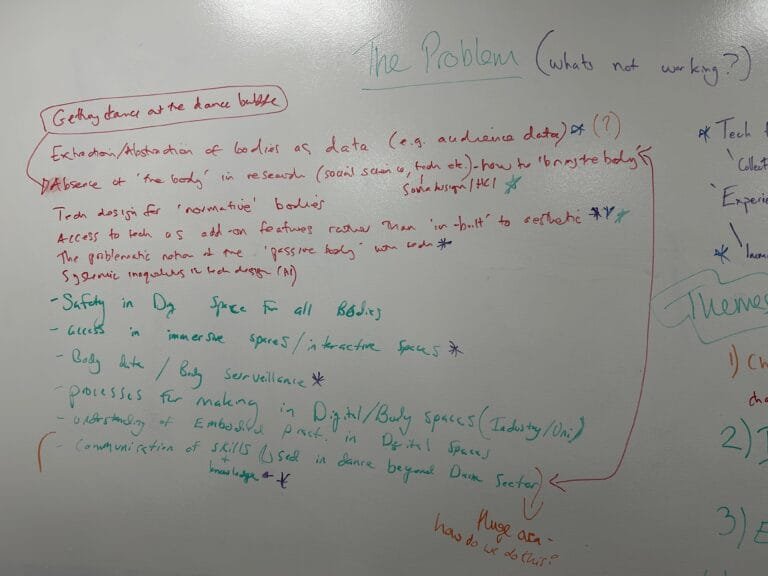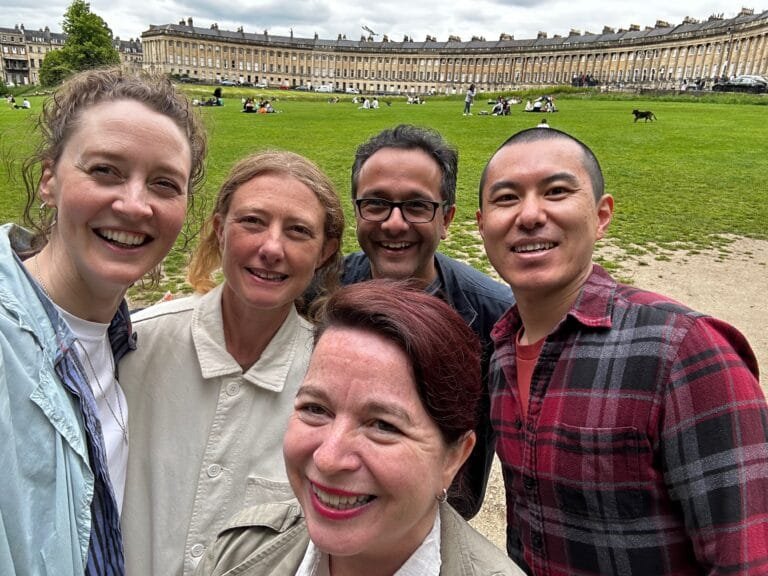
VR, AR, and immersive site-specific and interactive art experiences engage bodies with lived and virtual spaces in particular ways. They hold the potential to extend embodied, somatic experiences and connect people with multiple and simultaneous ‘spacetimes’ (Manning 2011).
On the 3rd June 2024, five researchers (movement artists and practitioner-researchers) working with AR and VR, digital somatic experiences, site-specific dance research, film, photography, and interactive art came together for a 1-day in-person workshop in Bath supported by The Studio (Bath Spa). Questions regarding how these practices employ, include (and exclude) particular constructions of live and virtual bodies, and the methods through which they extend visceral and somatic sensations shaped the workshop exchanges and dialogue. The event was funded by an NCACE micro-commission award and was preceded by an online preparatory pre-meeting (May 2024) that laid the groundwork and set the agenda for the day’s events.
Through shared interests in the nature and experience of embodiment, the researchers came together to explore how visceral and embodied sensations and somatically resonant spatial phenomena are applied in the development of live / hybrid performance and AR and VR movement work. The aim of this research is to better understand the shifting nature of digital embodiment in spatial computing, the role of embodied/somatic practitioner knowledge in future digital spaces and how this knowledge or methods developed from this research could impact wider industries that are moving into more immersive and interactive spaces that incorporate the body.
Participants included; Rebecca Evans Artistic Director and Choreographer of Pell Ensemble and Resident at The Studio (Bath Spa), Lisa May Thomas, independent dance artist and Senior Research Associate, ESRC Centre for Socio-Digital Futures (University of Bristol) and resident artist at Pervasive Media Studio, Naresh Kaushal, interactive art and moving image artist, Dr Zhi Xu (Bath Spa), Lecturer in Dance, technology and cultural identity and Professor Vicky Hunter, researcher in site-specific dance and human-place engagement (Bath Spa).
The Studio is Bath Spa University's creative and immersive tech and arts hub, as a research facility it is interested in developing a research area specifically focussing on immersive and extended digital dance & performance practices. The facilitation team at The Studio are interested in creating opportunities for immersive performance research and supporting performances and productions in the area to demonstrate this work.

Informed by their various practices and research interests the group came together to consider how somatically informed work in this area of dance and technology engages audiences and participants. They were keen to explore its potential to connect people across time and space, to consider how diverse bodies and cultural experiences can be included in this work and ultimately how this praxis expands and ‘stretches’ contemporary notions of embodiment in a digital age. The participants' long-term goal is to build collaborative relationships between academia and artists from the creative cultural sector to explore shared points of interest, articulate practices, methodologies, and theoretical perspectives and identify research questions that will lead them towards the development of a future collaborative funding bid application outcome.
The workshop day was structured around sharing information, discussion, creative thinking and identifying common areas of interest for future research and project development. Generic funding bid criteria and protocols were employed to help structure the day and to shape the activities. These included brainstorming, a ‘walk and talk’ session in which participants identified key questions and explored them through a ‘mobile’ discussion on foot, research visioning and creative questioning. These tasks and activities helped the group to identify ‘the problem’ and central themes for exploration, context and relevant current practices, identify potential outcomes of future collaborative research, possible beneficiaries, impact, and the research’s related potential for social good. Framed in this way the workshop day aligned with NCACE’s work and key themes through transferring knowledge and expertise between academic, cultural, and artistic domains and exploring the application of technology for social good.
Key learnings that emerged from the 1-day invent included;
- Learning about each other's practices and working methods and finding out more about each other's specific research concerns drawn from practice-based perspectives.
- Identifying a model for progressing the writing of a future funding bid via a series of meetings and writing workshops (subject to funding) over the coming year.
- Collectively the group imagined potential project activities in the form of choreographic labs, artists commissions, research meetings, knowledge exchange activities and symposia.
- Identifying potential funders to support the grant writing process.
- Identifying a common interest/ protocol for designing events, micro projects and tech with community groups and end users.
- Identifying a shared interest in diversity and inclusion informed by a questioning of who commonly gets to explore AR/VR and whose voices are excluded from this type of work and creative experimentation.
- Acknowledging a requirement to bring creative technologists and creative computing experts into the team as the grant writing moves forwards
The day provided an opportunity for valuable in-person exchange, to be in relation with one another and discuss in the same space and to engage in creative thinking together. The collaborative thinking and knowledge exchange between the group is at an early stage and the NCACE micro-commission funding provided an invaluable opportunity to carve out time and space for collective discussion and collaborative ideation to emerge, for ideas to float and for embodied thinking to take flight.
Second Image: Researchers (from left to right) Rebecca Evans, Lisa May Thomas, Naresh Kaushal, Vicky Hunter, Zhi Xu.
